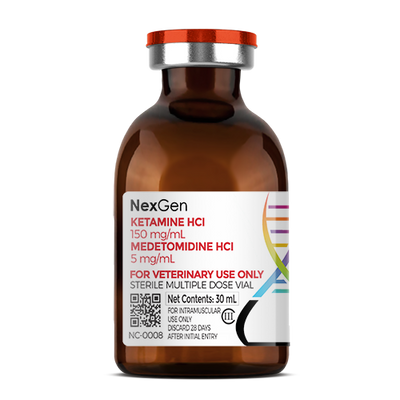
Medetomidine HCl 40 mg/mL, Injectable, (10mL)
Login for pricing
- Brand
- Mixlab
- SKU:
- NC-0529
- Product Type:
- Injectable
- Administration:
- Intramuscular
- Size:
- 10ml
Oftentimes, procedures that are routinely accomplished in companion animals with minimal restraint require sedation or anesthesia for exotic species, whether in the veterinary small animal practice, zoos or in the field.1 The chemical immobilization of captive exotic animals involves far more control and predictability of the environment than sedating or anesthetizing the same animals in the field, but it still requires an abundance of caution and planning, as well as the requisite skills and qualified personnel.
Although physiological responses during the maintenance of anesthesia are usually not different in a given species in the zoo versus in the field, successful induction and recovery require more knowledge and skills on the part of the veterinarian, staff and capture team (if applicable).2
While veterinarians in traditional practice settings are very well-versed in the action of commonly-used sedatives and anesthetics and the physiological responses of familiar domesticated species, it can be an ongoing challenge for some veterinarians to maintain stocks of the appropriate sedative and anesthetic drugs for exotic animals in small animal practices.
Medetomidine Hydrochloride
Medetomidine (medetomidine hydrochloride), used alone and in combination with other drugs, has been shown to be useful for the immobilization of exotic animals.3 Medetomidine is an α-2-adrenoreceptor agonist with sedative and analgesic properties. It is used by veterinarians as both a surgical anesthetic and analgesic. The pharmacological restraint and pain relief provided by medetomidine facilitates handling and aids in the conduct of diagnostic or therapeutic procedures. It also facilitates minor surgical procedures (with or without local anesthesia) and dental care where intubation is not required.
Where to buy Medetomidine
Medetomidine is available in the U.S. through pharmaceutical manufacturers and through veterinary custom compounding companies.
This product carries numerous potential drug interactions. Please consult your veterinarian prior to beginning any treatment regimen.
FOR RX ONLY: A valid prescription from a licensed veterinarian is required for dispensing this medication.
1Nielsen L. Chemical immobilization of wild and exotic animals. Iowa: Iowa State University Press, 1999; 227-281.
2Lewis JCM. Anesthesia of non-domestic cats. Hall, L.W., Taylor, P.M. Anaesthesia of the Cat. London: Bailliere Tindall, 1994; 310-349.
3Vähä-Vahe T. The clinical efficacy of medetomidine. Acta Vet Scand Suppl. 1989;85:151-3. PMID: 2571266.
4Plumb’s Veterinary Drugs.
5Di Pietro S, et al. Effects of a medetomidine-ketamine combination on Schirmer tear test I results of clinically normal cats. Am J Vet Res. 2016;77(3):310-314.




















